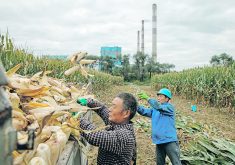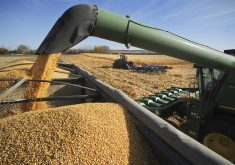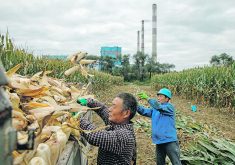The perception that many consumers have of modern farms can colour their expectations of the food they buy — so those perceptions should help shape how farms operate
When Canadian grocery buyers think about farmers, what images come to mind?
Do they see a trustworthy, tractor-driving character who wears a straw hat, striped coveralls and a red flannel shirt to work every day?
Or do they see low-income wage earners, working on a massive factory farm, where values such as environmental stewardship and animal welfare play second fiddle to more important motives like efficiency and profitability?
Is the consumer’s typical farmer someone who carries a pitchfork to work, picks free-range eggs by hand, and wakes up at day-break to care for animals that live in a red, hip-roofed barn?
Read Also

Trump’s tariffs take their toll on U.S. producers
U.S. farmers say Trump’s tariffs have been devastating for growers in that country.
Or is their typical farmer someone who produces hundreds of tonnes of unprocessed food every year and sells his product to a multinational processor or a globally integrated export company?
Is today’s farmer someone who applies more chemical pesticides than ever to his fields and grows genetically modified crops because they are easier to manage and more profitable?
Related stories in this issue:
- Farm groups challenge food company’s non-GM pledge
- Consumers searchfor trustworthy GMO information
- Grappling with GM animals
- Farmers have much to teach consumers
- Public’s anti-GMO perception tainted by media, say Green Party, NFU
- Case made for labelling, but questions abound
- Judge GM on a case-by-case basis: experts
- The debate over GM foods
- Consumers still opposed to GM food
- Divergence: If GM technology is safe, why don’t consumers trust it?
Or is he someone who cares for every plant by hand and manages his crops personally in hopes of ensuring safety and quality?
When it comes to food production and food marketing, imagery can be a powerful tool.
But in many cases, the images conveyed on food packages and supermarket shelves create a false perception of how many modern farms operate.
Similarly, the images and claims available to consumers through the internet and social media can be equally misleading, lending to a relationship of distrust and misunderstanding between the people who buy food and the people who grow it.
Agriculture has changed dramatically during the past few decades. But have consumer attitudes toward farmers and food production changed at the same pace?
The relationship between consumers and farmers was a key theme during a recent event hosted by Farm and Food Care Saskatchewan.
The Farmers at the Table conference, held Dec. 14-15 in Saskatoon, attracted almost 200 delegates.
The conference had many objectives. One of them was to dispel common myths about modern agriculture. Another was to close the gap between consumer expectations and the reality of modern farm practices.
“When it comes to trust, the three main issues with consumers right now are GMOs, antibiotics and animal welfare,” said FCCS executive director Clinton Monchuk.
“Those are the three main things that consumers have told us, through surveying, that they have concerns with. So our messaging going forward is going to be focusing on these issues.”
“We have a role to play in making sure that consumers understand and trust modern agriculture.”
Food economist Terry Scott, a speaker at the conference, said today’s consumers demand more information than ever about the food they consume.
Through their wallets, their computers and their smartphones, today’s grocery shoppers wield more influence than ever over the way food is produced and sold in North America.
For proof, doubters need only look at recent marketing campaigns launched by food retailers and restaurant chains such as McDonald’s, Earls and A & W.
With consumer influence at an all-time high, the need to gain consumer trust at all points of the supply chain has never been more important.
“What I’m finding with the primary producer within the last three years is that they’re more and more in tune with where consumer trends are going,” said Scott.
“They’re interested in learning about (consumer trends), they’re spending a lot of time on it and they’re thinking about it.”
“That said, the farming industry is not an industry … where attitudes change very quickly, and that’s not necessarily a bad thing.”
“It’s not unlike some of the big (food retail) companies, like Loblaw’s, Wal-Mart and McDonald’s. These companies don’t make decisions based on knee-jerk reactions and neither should farmers.”
The key, according to Monchuk and Scott, is to close the gap between consumer perceptions of agriculture and realities of everyday life on today’s modern farms.
Farmers need to be profitable. But they also need to be keenly aware of the importance that consumers place on issues such as environmental stewardship, animal welfare and food safety.
The use of GM crops presents an interesting case study.
According to Scott, food retailers and processors are capitalizing on opportunities to differentiate their products from others’.
Through differentiation, retailers can cater to specific segments of the food market.
For example, products that claim to be organic, gluten-free, natural, ethically produced, low-sodium or locally sourced are more common in today’s supermarket aisles.
Wiley consumers want to know what’s in their food, where it’s from and who’s behind it, Scott said.
Food sellers and food producers who answer these questions are more likely to gain a larger share of the overall food market.
“I don’t think (GMO labelling) should be mandated, but I think it should be voluntary,” Scott said.
“People want to know what’s in their food. So if your packaging voluntarily says GMO-free, then you are saying to a certain segment of the market that wants that particular type of product: ‘Here you go. Here’s a GMO-free product.’ ”
“I don’t think mandatory labelling is anything that’s going to get you anywhere, but I can see it as being a sales point of differentiation.”
Kevin Folta, a professor and chair of the horticultural sciences department at the University of Florida, also suggested that GMO labelling should be voluntary.
Largely through his presence on social media, Folta has positioned himself on the front lines of the debate over the safety of GM foods.
An outspoken supporter of GM technology, Folta insists that GM foods are safe for consumers, though perhaps not always for the environment.
“For health, they are absolutely safe and this has been determined through 20 years of use and (massive) amounts of testing before any products hit the market,” he said. “There are some environmental concerns that have come from the overuse of good technologies.”
“Weed resistance and insect resistance are examples of things that have come about because of too much reliance on GM technology but these are problems that are now getting new solutions.”
According to Folta, it’s a good thing that today’s consumers crave more information about the food they’re eating.
What’s often worrisome is how they fill that craving.
In their search for information, some consumers are turning to what Folta calls “merchants of doubt” — individuals and organizations that spread fear and misinformation about beneficial technologies such as genetic modification.
“I think it’s great that consumers want to learn more about their food,” Folta said.
“The problem is that scientists and agricultural producers have not been really excited to tell them. Going forward, I think it’s going to be an opportunity for us to share that information and to tell consumers the good things about agriculture and about food.”
Like Scott, Folta believes that voluntary labelling for GM products would be preferable to mandatory labelling
Instead of focusing energy on mandatory labels, the farming and food industries should spend more time defusing misinformation and building a higher level of trust with consumers.
“I think there’s opposition to (GM) labels because there’s still a perception out there that (GM) foods are somehow second rate or perhaps dangerous,” Folta said.
“I’m not so sure that consumers fully appreciate supply chains and the way food is produced,” he added.
“Instead, they go to the supermarket, they see the terminal products and they know that the ingredients came from a farm at some point. In many cases, they know very little about what it takes to get that food to their table.”
“Consumer trust will come when our best agents, the farmers themselves, are engaging the public directly.”
















